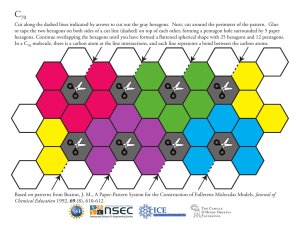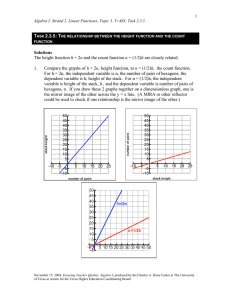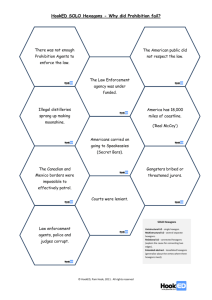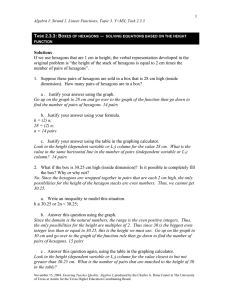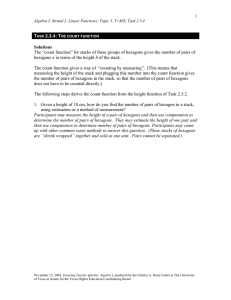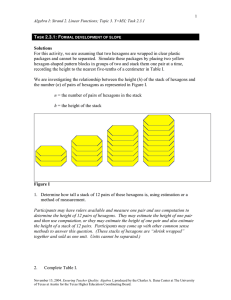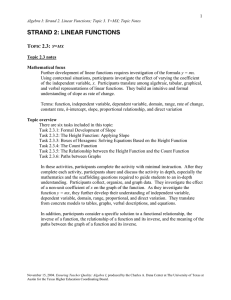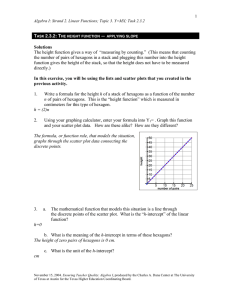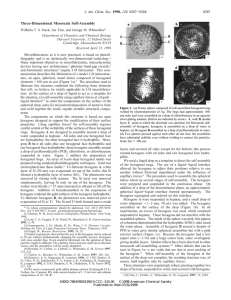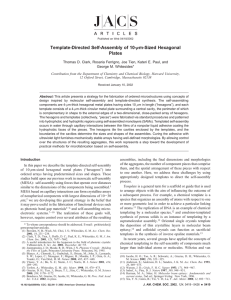Solutions T 2.3.6: P
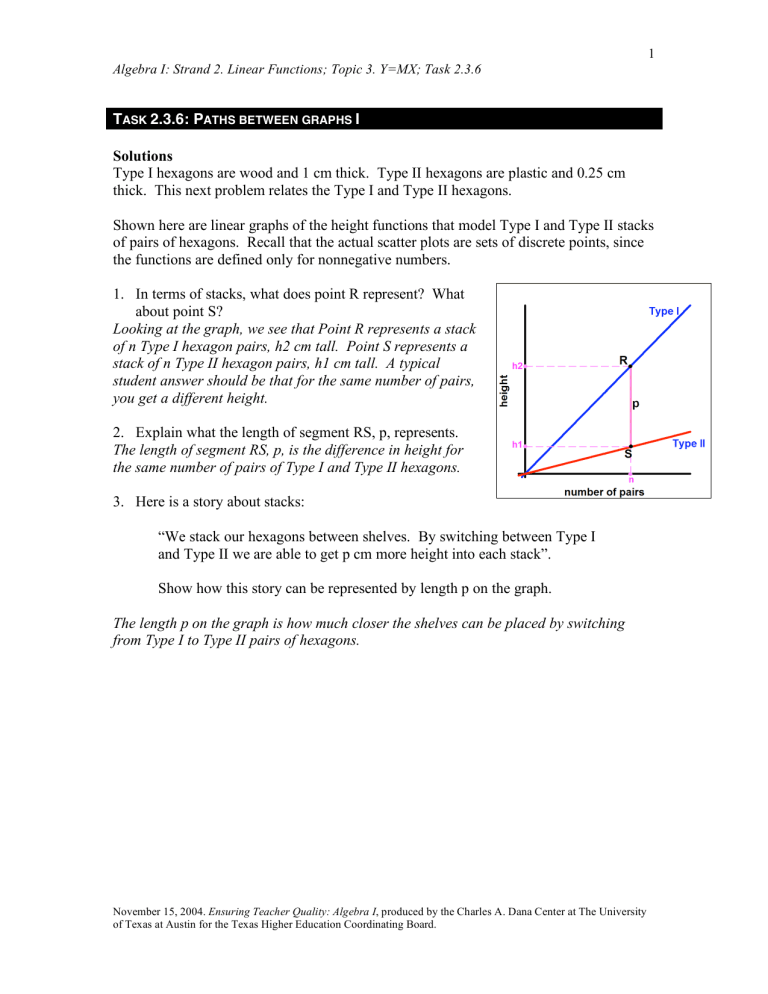
1
Algebra I: Strand 2. Linear Functions; Topic 3. Y=MX; Task 2.3.6
T
ASK
2.3.6: P
ATHS BETWEEN GRAPHS
I
Solutions
Type I hexagons are wood and 1 cm thick. Type II hexagons are plastic and 0.25 cm thick. This next problem relates the Type I and Type II hexagons.
Shown here are linear graphs of the height functions that model Type I and Type II stacks of pairs of hexagons. Recall that the actual scatter plots are sets of discrete points, since the functions are defined only for nonnegative numbers.
1. In terms of stacks, what does point R represent? What about point S?
Looking at the graph, we see that Point R represents a stack of n Type I hexagon pairs, h2 cm tall. Point S represents a stack of n Type II hexagon pairs, h1 cm tall. A typical student answer should be that for the same number of pairs, you get a different height.
2. Explain what the length of segment RS, p, represents.
The length of segment RS, p, is the difference in height for the same number of pairs of Type I and Type II hexagons.
3. Here is a story about stacks:
“We stack our hexagons between shelves. By switching between Type I and Type II we are able to get p cm more height into each stack”.
Show how this story can be represented by length p on the graph.
The length p on the graph is how much closer the shelves can be placed by switching from Type I to Type II pairs of hexagons.
November 15, 2004. Ensuring Teacher Quality: Algebra I , produced by the Charles A. Dana Center at The University of Texas at Austin for the Texas Higher Education Coordinating Board.
2
Algebra I: Strand 2. Linear Functions; Topic 3. Y=MX; Task 2.3.6
4. a. Explain what q represents.
The length q represents the number of additional pairs of hexagons that can be placed on the stack to attain the same height. b. What story might the length q represent?
Shelving space is limited. The space between the shelves is q cm. How many more pairs of Type II hexagons can be placed in a stack on these shelves than Type I pairs of hexagons?
5.
Where do the two lines intersect? What does the intersection of linear graphs represent? origin; The intersection of the two graphs represents the number of pairs of hexagons for which the heights are the same, which in this case is the point (0,0).
November 15, 2004. Ensuring Teacher Quality: Algebra I , produced by the Charles A. Dana Center at The University of Texas at Austin for the Texas Higher Education Coordinating Board.
Algebra I: Strand 2. Linear Functions; Topic 3. Y=MX; Task 2.3.6
T ASK 2.3.6: P ATHS BETWEEN GRAPHS I
For this activity, we are assuming that two hexagons are wrapped in clear plastic packages and cannot be separated. Simulate these packages by placing two yellow hexagon-shaped pattern blocks in groups of two and stack them one pair at a time.
We are investigating the relationship between the height ( h ) of the stack of hexagons and the number ( n ) of pairs of hexagons as represented in Figure I. n = the number of pairs of hexagons in the stack h = the height of the stack
3
Figure I
November 15, 2004. Ensuring Teacher Quality: Algebra I , produced by the Charles A. Dana Center at The University of Texas at Austin for the Texas Higher Education Coordinating Board.
Algebra I: Strand 2. Linear Functions; Topic 3. Y=MX; Task 2.3.6
Type I hexagons are wood and 1 cm thick. Type II hexagons are plastic and 0.25 cm thick. This next problem relates the
Type I and Type II hexagons.
Shown here are linear graphs of the height functions that model Type I and Type II stacks of pairs of hexagons. Recall that the actual scatter plots are sets of discrete points, since the functions are defined only for whole numbers.
1. In terms of stacks, what does point R represent? What about point S?
2. Explain what the length of segment RS, p, represents.
3. Here is a story about stacks:
“We stack our hexagons between shelves. By switching between Type I and Type II we are able to get p cm more height into each stack”.
Show how this story can be represented by length p on the graph.
4. a. Explain what q represents. b. What story might the length q represent?
5.
Where do the two lines intersect? What does the intersection of the linear graphs represent?
November 15, 2004. Ensuring Teacher Quality: Algebra I , produced by the Charles A. Dana Center at The University of Texas at Austin for the Texas Higher Education Coordinating Board.
4
